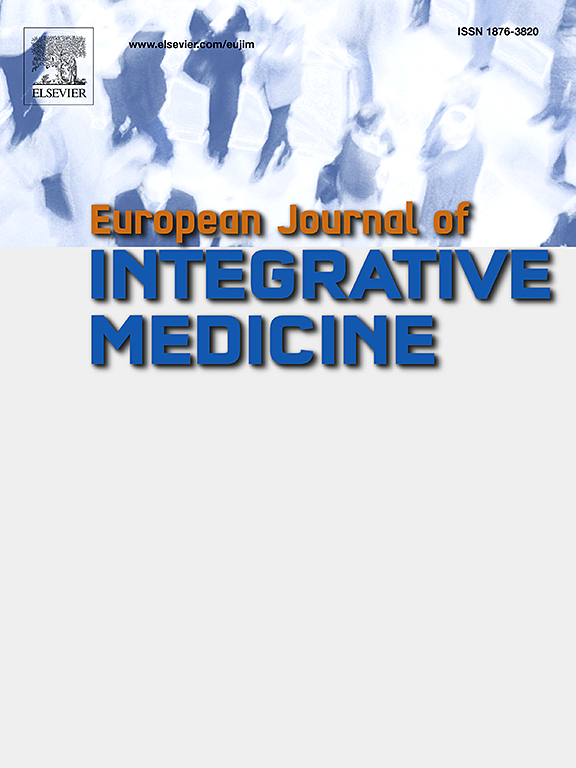放血疗法治疗感染性疾病引起的发热:随机对照试验的系统回顾
IF 1.7
4区 医学
Q3 INTEGRATIVE & COMPLEMENTARY MEDICINE
引用次数: 0
摘要
放血疗法(BLT)是一种中医非药物治疗方法,可能具有良好的解热效果,但证据尚未得到评价。本系统综述的目的是评估中药百来林注射液用于感染患者的解热效果和安全性。方法本综述的方案在PROSPERO杂志注册(No.CRD42023411059)。我们纳入了随机对照试验(rct),将BLT单独或与另一种疗法联合与对照组(无治疗或常规护理)进行比较。检索截至2023年3月的CNKI、万方、维普、中国医学信息网、Cochrane Library、PubMed、Embase数据库。采用Cochrane Risk of Bias 2.0工具和GRADE评估纳入试验的方法学质量和证据的确定性。结果共纳入14项随机对照试验(rct),共1419名受试者。BLT(单独使用或作为附加治疗)在增加解热率和降低体温方面优于单独使用药物,仅适用于成人。对于儿童或与小儿推拿或草药联合使用时,其优势并未显示出来。退烧时间可缩短(MD= -7.59 h, 95% CI -12.73 h至-2.44 h, 194例受试者,I2= 69%, 3项试验,P = 0.004),开始退烧(MD=-1.48 h, 95% CI -2.02 h至-0.94 h, 134例受试者,I2= 0%, 2项试验,P <;0.00001)作为小儿推拿的辅助治疗,其疗效有所改善。由于很少有试验报道这一相关结果,因此BLT治疗发热的安全性仍不清楚。证据的确定性非常低。结论成人长期(24hrs以上)单用或联用药物解热效果可能优于单用药物。小儿推拿/草药联合治疗与单独使用小儿推拿/草药相比,在提高退热率方面没有更好的效果。目前的证据并没有提供关于BLT安全性的确切结论。本文章由计算机程序翻译,如有差异,请以英文原文为准。
Bloodletting therapy to manage fever caused by infectious diseases: A systematic review of randomized controlled trials
Introduction
Bloodletting therapy (BLT), a traditional Chinese medicine (TCM) non-pharmaceutical therapy, may have a good antipyretic effect, but the evidence has not been evaluated. The aim of this systematic review was to assess the antipyretic effect and safety of TCM BLT used in patients with infections.
Methods
The protocol of this review was registered in PROSPERO (No.CRD42023411059). We included randomized controlled trials (RCTs) comparing BLT alone or in combination with another therapy to controls (no treatment or usual care). A search of CNKI, Wanfang, VIP, Sinomed, Cochrane Library, PubMed, and Embase databases was conducted up to March 2023. Cochrane Risk of Bias 2.0 tool and GRADE were used for assessing methodological quality of included trials and certainty of evidence.
Result
Fourteen RCTs (1419 participants) were included. BLT (either used alone or as add on therapy) was superior to drugs alone in increasing antipyretic rate and lowering the body temperature only for adults. For children or when combined with pediatric Tuina or herbal medicine, its advantages were not shown. The fever clearance time may be shortened (Mean Difference (MD)=-7.59 h, 95 %CI -12.73 h to -2.44 h, 194 participants, I2=69 %, 3 trials, P = 0.004) and the commencement of fever abatement (MD=-1.48 h, 95 %CI -2.02 h to -0.94 h, 134 participants, I2=0 %, 2 trials, P < 0.00001) improved when used as an adjunctive treatment with pediatric Tuina. Safety of BLT to treat fever was still unclear since few trials reported this relevant outcome. Certainty of evidence was very low.
Conclusion
The long-term (24hrs+) antipyretic effect of BLT alone and combined with drugs may be better than that of drugs alone for adults. For children combining BLT and pediatric Tuina/herbal medicine was no better in increasing antipyretic rate compared to pediatric Tuina/herbal medicine alone. Current evidence does not provide firm conclusions about the safety of BLT.
求助全文
通过发布文献求助,成功后即可免费获取论文全文。
去求助
来源期刊

European Journal of Integrative Medicine
INTEGRATIVE & COMPLEMENTARY MEDICINE-
CiteScore
4.70
自引率
4.00%
发文量
102
审稿时长
33 days
期刊介绍:
The European Journal of Integrative Medicine (EuJIM) considers manuscripts from a wide range of complementary and integrative health care disciplines, with a particular focus on whole systems approaches, public health, self management and traditional medical systems. The journal strives to connect conventional medicine and evidence based complementary medicine. We encourage submissions reporting research with relevance for integrative clinical practice and interprofessional education.
EuJIM aims to be of interest to both conventional and integrative audiences, including healthcare practitioners, researchers, health care organisations, educationalists, and all those who seek objective and critical information on integrative medicine. To achieve this aim EuJIM provides an innovative international and interdisciplinary platform linking researchers and clinicians.
The journal focuses primarily on original research articles including systematic reviews, randomized controlled trials, other clinical studies, qualitative, observational and epidemiological studies. In addition we welcome short reviews, opinion articles and contributions relating to health services and policy, health economics and psychology.
 求助内容:
求助内容: 应助结果提醒方式:
应助结果提醒方式:


